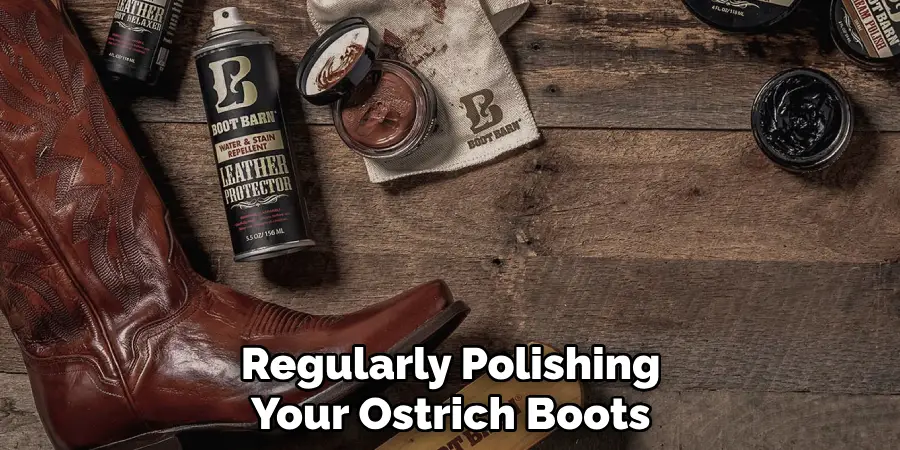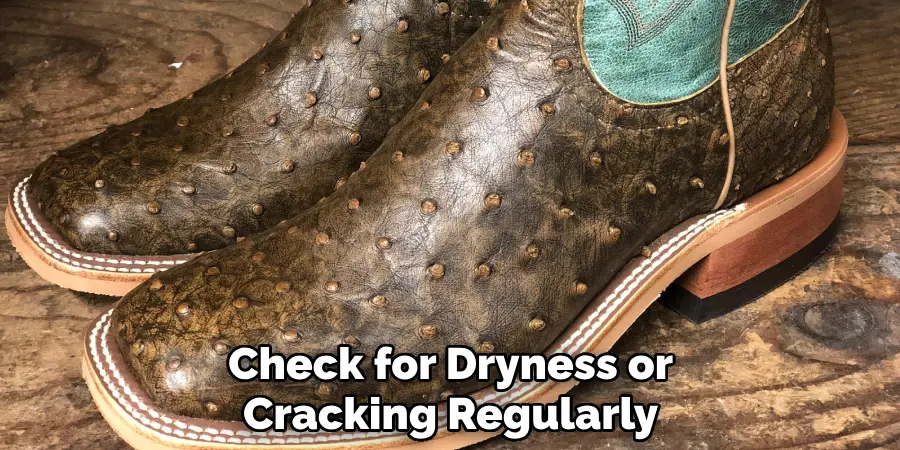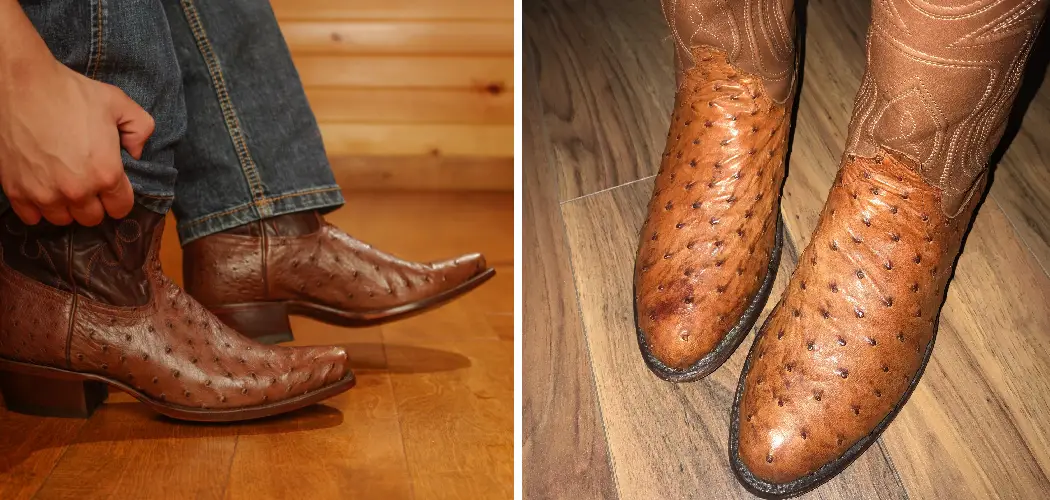Are you a proud owner of an ostrich boot and want to keep them looking fresh for years? If so, then you’ve come to the right place! In this blog post, we will go through all the details on how to condition ostrich boots correctly.

Ostrich boots are known for their unique and exotic appearance, making them popular among boot enthusiasts. However, as with any leather product, it is essential to care for them to maintain their beauty and longevity properly.
From proper cleaning techniques to determining when to cleanse your footwear deep, we have everything covered to ensure that your boots look their best. With some essential tips and advice from our team of experts, you can be assured that your ostrich boots look as good as new every time! Let’s get started now!
What Will You Need?
Before we dive into the essential steps on how to condition ostrich boots, let’s take a look at some of the necessary items you will need for this process:
- A quality leather conditioner specifically designed for exotic leathers
- Clean, soft cloth or sponge
- Leather cleaner (if needed)
- Soft brush
With these items, you are all set to start the conditioning process for your ostrich boots.
8 Easy Steps on How to Condition Ostrich Boots
Step 1: Cleaning Your OstrichBoots
The first step towards conditioning your ostrich boots is to ensure they are clean. Using a soft brush, gently remove any dirt or debris from the surface of your boots. You can also use a leather cleaner for any stubborn stains or marks.
Step 2: Preparing Your Boots for Conditioning
Once your boots are clean and dry, it’s time to prepare them for conditioning. Start by shaking the leather conditioner bottle well to ensure the solution is properly mixed. Then, dampen your soft cloth or sponge slightly.

Apply a small amount of the leather conditioner onto the cloth or sponge and spread it evenly. Remember, it’s better to start with a little and add more if needed. This helps to prevent over-conditioning, which can lead to a greasy finish and potential damage to the ostrich leather.
Step 3: Applying the Conditioner
Now, it’s time to apply the conditioner to your ostrich boots. Gently rub the conditioner onto the boot’s surface using a damp cloth or sponge. Make sure to cover the entire surface, paying special attention to areas of the boot that may seem dry or faded. Apply the conditioner in circular motions to ensure even coverage and penetration into the leather.
Take your time with this process; take your time to make sure the conditioner is thoroughly worked into the leather. Once done, allow the boots to rest for about 20 minutes to let the conditioner soak in.
Step 4: Removing Excess Conditioner
After allowing the boots to rest, inspect them for any spots where the conditioner may have accumulated or not fully absorbed. Using a clean, dry cloth, gently buff these areas to remove any excess conditioner.
This step is crucial as leaving too much conditioner on the boots can result in a sticky residue that attracts dirt and dust. Always remember, less is more when applying conditioner on ostrich leather. It’s about maintaining the moisture balance of the leather without oversaturating it.
Step 5: Drying Your Boots
After removing excess conditioner, it’s time to allow your boots to dry. Letting the boots dry naturally rather than using a heat source like a hairdryer or radiator is important, as this can cause the leather to shrink or crack.
Place your boots in a cool, well-ventilated area, avoiding direct sunlight or heat sources. Allow the boots to dry for at least 24 hours to ensure the conditioner is fully absorbed and completely dry. Don’t rush this step – proper drying is crucial to conditioning your ostrich boots.

Step 6: Polishing Your Boots
The final step in the conditioning process is to give your boots a good polish. This enhances the look of your boots and provides an additional layer of protection. Use a leather polish that matches the color of your boots. Apply the polish with a clean, dry cloth, using circular motions.
Once the entire boot has been covered, use a separate clean, dry cloth to buff the boots to a shine. Now, your ostrich boots are conditioned, dry, and polished, ready to make a statement! Regular maintenance and conditioning will keep your boots looking great and ensure their longevity.
Step 7: Regular Maintenance
To keep your ostrich boots in the best condition, it’s important to follow a regular maintenance routine. Depending on how often you use your boots, you should condition them every month or two.
Always remember to clean your boots before conditioning them. Dust or dirt can become ingrained in the leather, causing it to degrade. By following these steps on condition ostrich boots, you can help prevent this and ensure the longevity of your boots.
Step 8: Storing Your Boots
Proper storage of your ostrich boots is crucial in maintaining their shape and preventing unnecessary wear and tear. When not in use, store your boots in a cool, dry place away from direct sunlight or heat sources, which can dry out and crack the leather. Consider using boot shapers or inserts to help maintain the shape of your boots during storage.
Avoid storing your boots in plastic bags or boxes, as these can trap moisture and lead to mold and mildew growth. Instead, opt for a breathable bag or box for leather boot storage. By following these storage tips, you can ensure your ostrich boots continue to look their best for years.
With these easy steps, you can confidently condition your ostrich boots at home and keep them looking their best. Remember always to use high-quality leather conditioner and follow a regular maintenance routine to ensure the longevity of your boots.
5 Additional Tips and Tricks
- Avoid Excess Moisture: Ostrich leather is susceptible to water damage. Therefore, always make sure your boots are dry before you start the conditioning process.
- Use the Right Conditioner: Use a conditioner specifically designed for ostrich leather. This ensures that the oils and fats used in the conditioner will not harm the ostrich hide.
- Applied Moderation: Overconditioning can make the leather too soft, impacting the boot’s structure. Apply a small amount of conditioner and more if necessary.
- Polish Regularly: Regularly polishing your ostrich boots will keep them looking fresh and new. Use a colorless or matching color polish to avoid discoloration.
- Keep Your Boots Away from Heat: Exposure to heat can cause the leather to dry out and crack. Therefore, storing your boots in a cool and dry place is important.
Following these additional tips and tricks ensures that your ostrich boots stay in top condition for years.

5 Things You Should Avoid
- Avoid Direct Sunlight: Ostrich leather can fade or become discolored when exposed to direct sunlight for extended periods. Make sure to store your boots in a shaded area to prevent this from happening.
- Stay Away from Harsh Chemicals: Chemicals like bleach, alcohol, or acetone can damage the ostrich leather and strip away its natural oils. Always use products specifically designed for ostrich leather.
- Avoid Excessive Rubbing: While conditioning and polishing, avoid rubbing too hard, as it can lead to unnecessary wear and tear.
- Ignore Dry Cleaning: Dry cleaning methods can be too harsh for ostrich leather, leading to damage over time. It’s best to clean your boots manually using the right products.
- Neglecting Regular Maintenance: Regular maintenance is key for longevity. Neglecting to condition or polish your ostrich boots regularly can cause them to lose their appeal and durability. By avoiding these pitfalls, you can ensure the longevity of your ostrich boots.
You can keep your ostrich boots looking luxurious and pristine for years by avoiding these pitfalls and following the right techniques.
How Often Should You Condition Ostrich Boots?
The frequency of conditioning your ostrich boots depends on the amount of wear and exposure to elements they receive. Generally, it is recommended to condition them every 3-6 months. However, if you live in a dry climate or wear your boots often, you may need to condition them more frequently.
It is important to monitor the leather and check for dryness or cracking regularly. If you notice any signs of damage, it is best to condition your boots immediately to prevent further deterioration.

Following these tips and guidelines lets you keep your ostrich boots looking and feeling their best. Remember, regular maintenance and using the right products is the key to keeping any leather product in top condition.
Conclusion
After reading this guide, you should better understand how to condition ostrich boots. Regardless of the conditions, it is important to take preventative measures and keep your leather protected; use moisturizers, protective oils, or waxes in order to seal out water and keep your ostrich boots looking fresh.
Remember that prevention is always the best remedy for any material. Another tip to remember: Professional shoe polishes are great for conditioning ostrich leather. So don’t be afraid to spend a few extra dollars for good quality leather cleaners that can make a difference in the long run.
Time after time, taking these steps will ensure that your ostrich boots remain spotless and last you for years into the future.
Remember- when protecting your ostriches from dirt, debris, or moisture build-up, proper leather conditioning is key!

